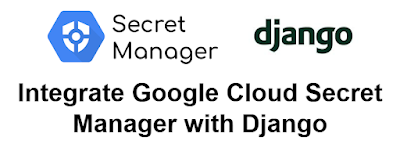Integrate Google Cloud Secret Manager with Django

To integrate Google Cloud Secret Manager with Django, follow these steps: 1. Set Up Google Cloud Secret Manager Enable Secret Manager API : Go to the Google Cloud Console . Enable the Secret Manager API for your project. Create a Secret : In the Secret Manager section, click on Create Secret . Give it a name (e.g., my_database_password ) and input the secret value (e.g., an API key, database password, etc.). Click Create . Set Permissions : Make sure your service account (used by your Django app) has the Secret Manager Secret Accessor role, which allows it to access the secrets. 2. Install Google Cloud SDK and Required Libraries You need to install the Google Cloud SDK and libraries for Python. pip install google-cloud-secret-manager 3. Configure Authentication Ensure that your Django application has access to Google Cloud. You can authenticate using a service account key. Create a service account : Go to the IAM & Admin section . Create a service account with the Secret Manager ...




